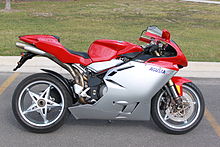Massimo Tamburini
Massimo Tamburini (born November 28, 1943 in Rimini , † April 6, 2014 in San Marino ) was an Italian designer.
Life
Massimo Tamburini was born in 1943 to a rural family. He went to the Istituto Tecnico Industriale di Rimini , but for health reasons he did not attend until graduation. At the age of 18 he had completed training in the sanitary and heating sector. In 1961 he married his wife Pasquina, with whom he had three sons - Morena, Andreas and Simon.
After Tamburini was diagnosed with lung cancer in November 2013, he died in April 2014 in a hospital in San Marino.
Career
The first motorcycle that Tamburini completely rebuilt was a MV Agusta 600 Turismo in 1971 , which he converted to 750 cm³ and chain drive instead of cardan drive. With a self-made tubular frame, with a new aluminum tank and a new rear section, a remarkable sports motorcycle was created.
In 1973 he founded the company Bimota - Bi anchi Mo rri Ta mburini - with Valerio Bianchi and Giuseppe Morri in 1973 to build motorcycles. A major impetus for founding the company was his fall with a Honda CB750 Four on the Misano race track in the Quercia hairpin in the same year.
"Non fossi caduto alla Quercia forse non avrei nemmeno fatto le Bimota."
The rebuilding of the motorcycle was then the prototype of the first series from Bimota, the HB1 750 - H onda B imota 1 with 750 cm³. This was followed by a number of sports motorcycles, which were always built with bought-in engines from large-scale manufacturers, but in their own design and with trend-setting chassis in small series.
“What I really enjoy is the technology. I became a designer because Bimota couldn't afford one. "
After leaving Bimota in 1983, he worked for a short time in the Suzuki racing team of Roberto Gallina, who had the racing driver Franco Uncini under contract.
In 1985, the aspiring motorcycle entrepreneur Claudio Castiglioni, who had also acquired Ducati in the same year, brought him to Cagiva . Tamburini became head of the CRC (Cagiva Research Center) in San Marino - near his hometown Rimini, which he did not want to leave. In 2008 he left the company.
Works (selection)
Massimo Tamburini developed numerous trend-setting motorcycles.
- 1975: Bimota HB1 750
- 1980: Bimota KB2 (steel frame made of straight tubes with a pivot point coaxial with the chain pinion; engines from the Kawasaki Z 500 and Z 550 )
- 1981: Bimota HB2 (hybrid frame made of milled aluminum parts and steel tubes with motors from the Honda Bol d'Or series )
- 1985: Cagiva Aletta Oro 125
- 1986: Ducati Paso 750
- 1987: Cagiva Freccia C9
- 1994: Ducati 916
- 1998: MV Agusta F4
- 2001: MV Agusta Brutale
Web links
- Eva Breutel: Massimo Tamburini died. A big one has gone. Motorrad (magazine) , April 7, 2014, accessed on August 25, 2016 : "The famous motorcycle developer and designer Massimo Tamburini is dead. He died on Saturday night at the age of 70 in his hometown of Rimini."
Individual evidence
- ^ Sigismondo d'Oro a Massimo Tamburini. In: Motori. La Stampa , December 19, 2012, accessed August 26, 2016 (Italian).
- ↑ Bruno Deprato: Massimo Tamburini, 1943-2014. Remembering one of the greatest innovators in motorcycle chassis design. Cycle World, April 6, 2014, accessed August 24, 2016 .
- ^ Margalit Fox: Massimo Tamburini, Sculptor of Shapely Motorcycles, Dies at 70. In: Business Day. The New York Times , April 9, 2014, accessed April 28, 2014 : "They were objects of unalloyed lust."
- ↑ a b Eva Breutel: Portrait Massimo Tamburini. (PDF) Il Massimo. Motorrad (magazine) , 2004, accessed April 28, 2014 .
- ↑ a b Nico Cereghini: E 'morto Massimo Tamburini. Moto.it , April 6, 2014, accessed May 29, 2014 (Italian).
- ^ Ralf Schneider: Massimo's motorcycles . In: motorcycle . No. 24 , 2014, ISSN 0027-237X , p. 24–38 (MOTORRAD has a list, written by Massimo Tamburini, of the motorcycles he has developed).
| personal data | |
|---|---|
| SURNAME | Tamburini, Massimo |
| BRIEF DESCRIPTION | Italian designer |
| DATE OF BIRTH | November 28, 1943 |
| PLACE OF BIRTH | Rimini |
| DATE OF DEATH | April 6, 2014 |
| Place of death | San Marino |
